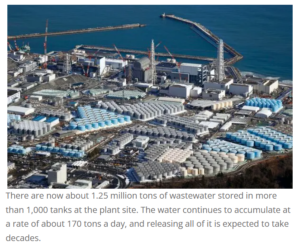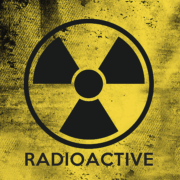A Modern Day Nuclear Legacy; first the Fukushima Meltdown, now Radioactive Ocean Dumping
BeyondKona first reported April 24, 2021 (story link above) on Japan’s Tepco announced intentions to engage in multiple controlled releases of highly radioactive wastewater into the Pacific Ocean, and near the site of the Fukushima nuclear plant disaster of 2011.
Fukushima wastewater contains among over 50 radioactive elements, including plutonium isotopes considered to be one of, if not the most toxic, element known to humankind and exclusively created by humans and not by nature.
The Fukushima Daiichi nuclear power plant meltdown in 2011 contained substantial releases of plutonium 239 which has a radioactive half-life of 24,110 years (the forever factor) and plutonium 240 which carries with it a half-life 6,561 years – also a forever radioactive and highly toxic element to humankind, now forever introduced into the Pacific Ocean — and certainly much more alarming than the self-proclaimed “careful and concerned” Japanese power utility would led its domestic audience and the world to believe.
Previously reported, 84 percent of water held at Fukushima contains concentrations of radioactive materials higher than legal limits allow to be dumped. Among the deadly isotopes still in the Tepco wastewater discharges are cesium-137, strontium-90, cobalt-60, ruthenium, carbon-14, tritium, iodine-129, plutonium isotopes 239 and 240, and more than 54 more radioactive elements.
 The implied Tepco argument and focus has been on the release of cesium-137 and its 30 year toxic lifespan into the marine ecosystem and food chain. The utility argues that its radioactive waste dumping activities are benign to the environment (meaning people, fish, and the marine ecosystem).
The implied Tepco argument and focus has been on the release of cesium-137 and its 30 year toxic lifespan into the marine ecosystem and food chain. The utility argues that its radioactive waste dumping activities are benign to the environment (meaning people, fish, and the marine ecosystem).
The utility’s public reporting focus on the 30 year toxic lifespan of cesium-137, and in the tone of its alright – no worries argument just doesn’t hold water, and further fails the truth omission test as to the less comforting reality of 6,500 – 24,110 half-life years of the plutonium elements within Tepco’s toxic wastewater presently, and planned for ocean dumping of radioactive water releases.
The cancerous outcomes radioactive wastewater releases will have on fish and people further up the food chain remains fully unqualified and unknown by the utility and Japanese government. The current wait and see attitude as to the radioactive consequences this dumping is unacceptable by any measurement of common sense.
The black rockfish caught in the ocean on 18 May 2023 by plant operator Tokyo Electric Power Company (Tepco) were found to have 18,000 becquerels per kilogram of cesium-137, compared with the legal maximum level of 100 becquerels per kg. allowed. Plutonium and other toxic radioactive wastewater elements in the ocean releases have so far not been publicly reported by the utility or government.
We do know this much, when asked about public concerns over radioactive water discharges in the Pacific Ocean, a Tepco official and spokesperson reiterated that the company was confident that “the impact on the public and environment will be minuscule”.




In graduate school, I made an effort to learn as much as I could about radiobiology. The dose-response in people and animals is linear! That is to say; there is no safe dose threshold. TEPCO proved it cannot be trusted at all, and for them to say the biological impacts of releasing the radioactive water into the sea is minuscule is fictitious and not supported by science. I trust TEPCO as far as I can throw them.
Yikes! No more sushi bars for me…
Would really like to know more about the Japanese’s own domestic environmental groups and their responses to this debacle.